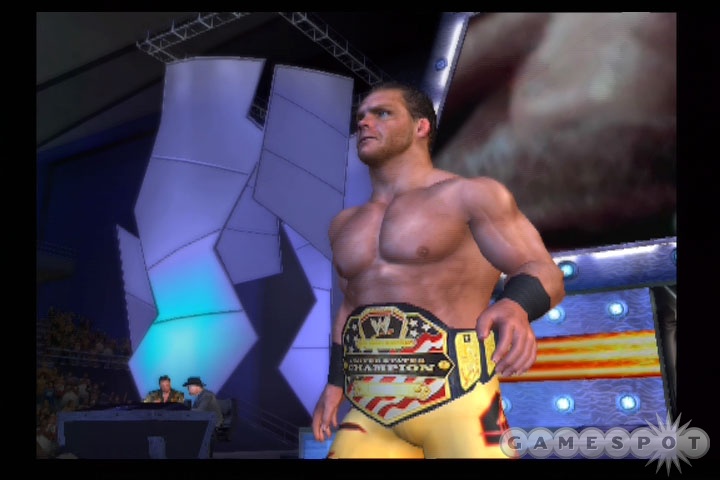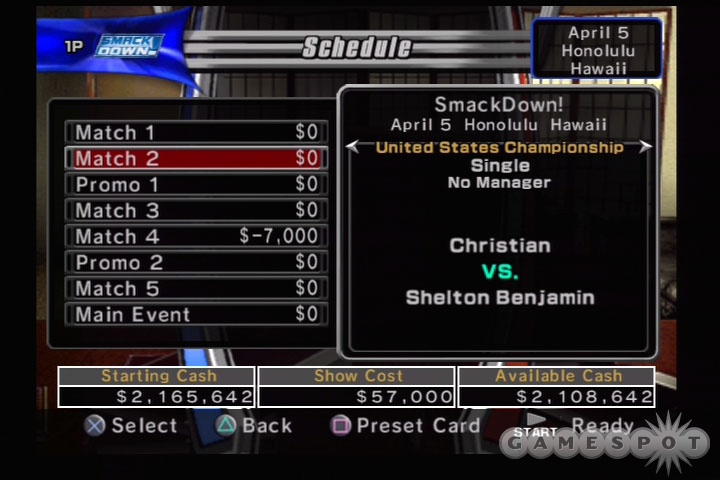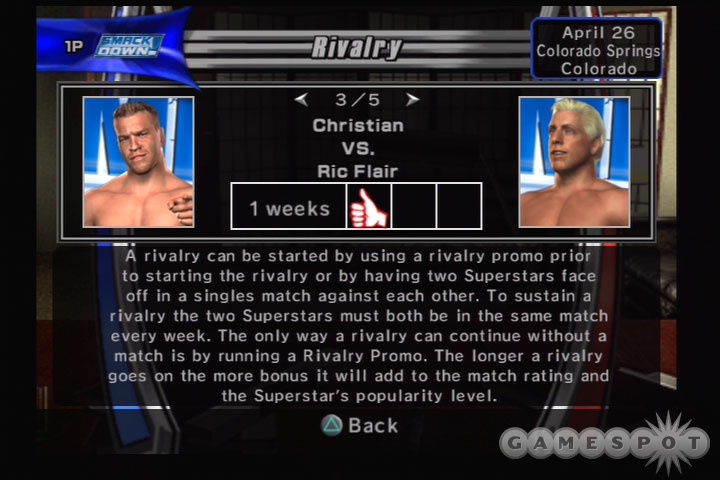WWE SmackDown! vs. Raw 2006 GM Mode Spotlight
Straight from the Yuke's development team in Japan: We go behind-the-scenes of SmackDown! vs. Raw 2006, plus an inside look at the all-new GM mode.
YOKOHAMA, JAPAN--It's easy to see that the Yuke's development team behind THQ's WWE SmackDown! vs. Raw 2006 is a thoroughly enthusiastic bunch of wrestling fanatics. They come to greet you wearing the paraphernalia of their favorite wrestlers, and if you ask them who their favorite WWE superstar is, you'll likely be treated to a thoughtful and impassioned answer; a response that is typically much more in-depth than what you might be used to.
Consider the answer of SmackDown! vs. Raw 2006's season mode director Yoshio Togiya, whose favorite wrestler is Chris Benoit: "Chris Benoit used to wrestle with New Japan. Seeing him win championship in WrestleMania (20) almost brought tears of joy to my eye. Watching his career, from hard times in Japan up through his great success in the WWE, makes me feel kind of like a parent watching his child grow up and be successful."
This kind of fandom runs rampant throughout the Yuke's SmackDown! development team. Recently, we had a special opportunity to visit the Yuke's office in Yokohama to see firsthand how the team has been going about putting together the latest game in the SmackDown! series: WWE SmackDown! vs. Raw 2006. The team has been working on the game since before the first SmackDown! vs. Raw game was released last year, and now that the game is in a nearly complete state, it's easy to be impressed with the amount of work and dedication the team has poured into the game.
Yuke's has been the sole developer of the SmackDown! games since the series' inception on the original PlayStation in 2000. Since that original game, with its fresh concepts and new takes on some staid wrestling traditions--most notably the introduction of a story mode (which was truly introduced in SmackDown! 2)--the developer has strived to continually push the development of the series in new directions. Story has since become a central feature in every subsequent SmackDown! game, and that is certainly the case in 2006. (For our look at the story mode in SVR 2006, read our most recent hands-on preview here).
The job of keeping the storyline straight in an ever-changing WWE world is not as easy for the Yuke's crew as you might think. While the WWE broadcasts both of its brand-name shows in Japan, as series director Taku Chihaya explained, the broadcasts are on a necessary three-week delay. "For the Japanese broadcast, because story is so important, [the WWE adds] subtitles--just like movies--on the Japanese broadcast, and of course that takes some time," Chihaya said. "So that's what accounts for the delay. And realistically, it is easier for us to understand the nuances of the story and what's going on when we have the subtitles there and not just the voice because, you know, we don't understand English well enough to get all of that. So the delay is just something we have to live with."
Still, as Chihaya points out, the team has ways of keeping up with the latest title and storyline changes. "Especially in the later part of the project, we need to keep up with developments as quickly as they happen because we want to have the game be as current as possible," Chihaya said. "So one example being every year's summer PPVs, we don't know what the arenas are going to look like [until] they've actually had the PPV. In that case we need to get the information really quickly, so we ask THQ to record events for us and send them to us. We also check WWE.com to see who's been fired, who changed their costume, and stuff like that; and try to keep up with the latest information so we can have the game be as current as possible."

When it came time to write the basic storyline for the SVR 2006, the Yuke's team worked closely with a team of WWE scriptwriters to ensure authenticity. In fact, the entire plotting process is a collaboration between Yuke's, THQ, and the WWE to make sure the most popular wrestlers are being showcased at the right time when the game comes out.
Last year's SmackDown! vs. Raw game was the first wrestling game to feature online play. The Yuke's development team responsible for putting together the online feature set for last year's game and SVR 2006 don't downplay the initial difficulty the team experienced while trying to make online play work. "The biggest problem we had was that we had online play working fine here, within the Internet environment we have here at the office," said Shintaro Matsubara, technical director at Yuke's. "But when we took the game over to America for testing and used it with real ISPs and a wide variety of ISPs in the states, we found the game didn't work at all in some cases, and we had lots of problems with performance as well. We were really worried about whether we would be able to get online, basically functioning or not, when we saw how many problems we were having in the real environment." Still, the team managed to overcome those initial difficulties and has returned this year with a game whose slate of online features is far more fleshed out than last year's effort--including approximately 70 different match types playable online for up to four players. "We had some new, different problems this year," Matsubara said, "but basically, the experience we had last year helped us deal with them much better."
It's Your Show
While SmackDown! vs. Raw 2006 will have plenty of new features to boast when it's released in a scant few weeks--new backstage brawl environments, a casket match, a new WWE divacentric Fulfill Your Fantasy match, and the aforementioned upgraded online play--the biggest addition to the game is an entirely new gameplay mode, one that will likely leave hardcore wrestling fans giddy in anticipation: the General Manager mode. We had a chance to see GM mode for the first time at the Yuke's studio, and we were given a guided tour of the new feature by its designer, Kenji Nakamura.

As the name implies, GM mode will put you in the shoes of either Eric Bischoff, current Raw general manager, or Theodore Long, who's running SmackDown! these days. Your goal in the game will be to win as many fans as you can for your show, while stealing fans away from the other WWE broadcast in the process. Over the course of one broadcast year, it will be your responsibility to sign a roster of WWE talent, book weekly shows and monthly pay-per-views like No Mercy, WrestleMania, and Summer Slam, deal with the vagaries of show finances, and basically do whatever it takes to ensure that, after your year is up, you end up with more fans than the other guy.
The mode starts you off in an audacious fashion. After you choose which show you wish to run, you're put in a head-to-head talent draft and given a chance to draft up to 20 WWE superstars for your roster. You can choose the contract length for each wrestler you choose--from a few short weeks to as long as a full year--with the realization that you only have a limited amount of money to spend on talent; and you'll need to make sure your coffers aren't empty when it comes time to put on the weekly shows--show promotion and special match types such as cage matches cost money, after all. Furthermore, choosing your roster is a bit more in-depth than simply filling up your spots with your favorite grapplers and then starting the show. For one thing, each show has a slightly different championship-belt lineup--Raw is the home of the women's championship, while SmackDown! hosts the cruiserweight championship. Furthermore, each wrestler will have a popularity rating that will add to your show's ability to draw fans. You might not be the biggest fan of the Undertaker, for example, but if he's available to you in the early rounds, it's in your best interest to snatch him up.
Each roster has a maximum of 20 slots, but you aren't required to use that many; however, Yuke's producers told us it's a good idea to have at least 12 wrestlers in your stable. You can even sign up created wrestlers as free agents on to your card--though they'll likely have a tough rode to travel in gaining the popularity of current WWE stars. Once you've got your roster worked out and have assigned championship belts to whomever you like, it's time to get to the central job of the general manager--booking shows. For each broadcast of Raw or SmackDown!, you'll have a number of matches and promo slots to fill. Building a card is as simple as slotting in various match types in the "match" segments of a show and choosing from a number of different promos during "promo" segments. By choosing a specific slot, you can fill it with any combination of wrestlers in your roster, give them a match type to compete in, decide if it will be a title or non-title bout, and choose from other options, such as whether or not managers will be allowed to escort the wrestlers.

But that's not all. In addition to standard match types, there are a number of different types of nonmatch options you can use to fill up slots on your show. You can run rivalry promos, for example, to build up the tension between two feuding superstars (more on rivalry in a bit), build up hype for the night's main event or an upcoming pay-per-view, or even decide to run some smack on your opponent's promotion, hoping to draw away fans from their played-out programming to your fresh, cutting-edge cards. If you really want to lay down the gauntlet, you can even run an interference promotion on your opponent and have select members of your roster invade the other show in an all-out assault on their ratings. Other promos to choose include everything from introducing a newly acquired superstar to build some hype, to running an "inactive superstar" promo, which lets you rest a member of your roster and maintain his popularity at the same time.
Rivalries = Cash
One of the key elements of success to any good wrestling promotion is the rivalry. Everyone remembers classic grudge matches between stars like Ric Flair and Harley Race, Ricky "The Dragon" Steamboat and Randy Savage, and even more current feuds, like that between Flair and Triple H. In SmackDown! vs. Raw 2006's GM mode, you'll be able to create an entirely new set of rivalries between foes who may have never stepped in the ring together. All you need to do to start a rivalry is have the same set of wrestlers meet in the ring over multiple weeks. The more often a pairing squares off in the squared circle, the more heat that rivalry will bring. If you time things right, you can build up a rivalry to the boiling point and set yourself up for a huge payoff at a pay-per-view event, where you can really give the fans what they want.

Once a card is set, you can choose to either simulate or play through any of the matches you've organized, and after the show is over, your performance will be graded on a simulated version of WWE.com. Both shows will receive "star" ratings (with five stars being the best show possible); you'll also be able to see a running tally of total fans for each show, as well as the weekly swing in fan loyalty from week to week. As long as you're taking fans away from the other guy, you'll be in good shape.
As you progress through the season, you'll be able to check out your progress on your roster, propose trades with your rival brand, pick up free agents to fill out your roster, or check out your current champions at any time. You'll also be able to check out your financial performance on a weekly basis to see how your promotion is drawing in the dollars. If you're running low on cash, you can choose to run a sponsored product promotion to fill your coffers--but run too many of these and the quality of your show will suffer. Periodically you'll receive e-mails from folks like J.R. or Taz, who will offer you helpful hints on how you can improve your promotion from week to week. You won't have the opportunity to jump in the ring and do Bischoff-style promos or run screwjobs on the good guys, but the opportunity to set up a number of dream matches from week to week should make up for that.
At the end of your year as general manager, just after the WrestleMania pay-per-view, the ratings will reset and you'll be able to steal three members of your opponent's roster (he'll be able to take three of your top superstars as well) and the whole vicious cycle will start over again. We're excited by what we've seen of GM mode so far in SmackDown! vs. Raw 2006. It's a concept that seems to make a lot of sense in today's wrestling climate, in which everyone fancies themselves a better booker than those on TV, and there is no doubt that if GM mode takes off in SVR 2006, there is a lot room for some fascinating developments in the future.
SmackDown! vs. Raw 2006 for the PS2 is just a scant few weeks away, and we'll have much more on the game, including a full review, in the coming days. For more on the game, including the straight dope from the Yuke's development team, be sure to check out the SmackDown! vs. Raw 2006 media page. And be sure to check back next week for a special behind-the-scenes look at the Yuke's SmackDown! studio straight from Japan.
Editor's note 11/04/05: The preview originally stated that you would not be able to use created wrestlers in GM mode, which is incorrect. GameSpot regrets the error.
Got a news tip or want to contact us directly? Email news@gamespot.com

Join the conversation